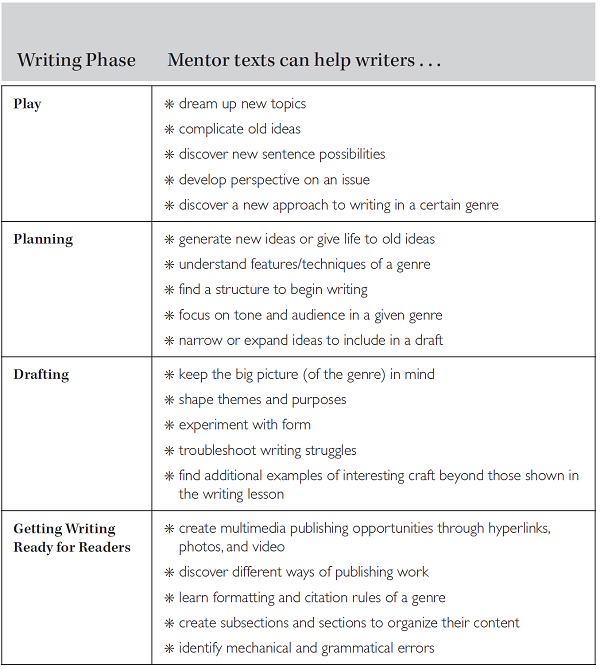
In Writing with Mentors, high school teachers Allison Marchetti and Rebekah O’Dell prove that the key to cultivating productive, resourceful writers—writers who can see value and purpose for writing beyond school—is using dynamic, hot-off-the-presses mentor texts. Today, Allison and Rebekah argue that mentor texts should be used in all phases of writing—planning, drafting, revision, and publication.
Mentor Texts for All Phases Of Writing
by Allison Marchetti and Rebekah O'Dell
Imagine a room filled with the quiet buzz that always accompanies writing as students dig in to their study of critical reviews. Reed skims several restaurant reviews by Pete Wells, restaurant critic for The New York Times, pausing to jot down notes in the margins. Studying the reviews gives him a feel for what kind of information he might need in his own review--service notes, food descriptions, and so on. Nearby, Ari prepares for drafting. She studies John Green’s review of Eleanor & Park, searching for a possible structure for her own work. Further along in the process, Cole checks his commas against The A.V. Club’s Ryan Smith’s punctuation in a game review of Titanfall. Others listen to Ken Tucker’s Fresh Air podcast of his review of Pharrell Williams’ album G I R L as they ready their own podcasts for publication…
Mentor texts have the potential to inspire and teach students at every step of the writing process, from play and experimentation with words, to planning for writing, to crafting and revising, to publishing. Throughout a unit of study, students choose mentor texts that will help them most in their writing at any given time.
As teachers, we should understand all the different ways mentor texts might support writers in different phases of the writing process so we can help students engage with the texts they choose. For instance, in the scene above, the students are working on critical reviews, using a cluster of mentor texts of various kinds of reviews to help them craft their pieces. They chose from mentor texts the teacher provided—before they ever began writing—to learn the conventions of the genre and to help them generate ideas. As they begin drafting, some of these students might borrow from John Green’s Eleanor and Park review for its thoughtful opener. In the thick of drafting, others may get stuck and return to a mentor text to help them figure out what might come next, what they are missing, or how to conclude. Later down the road, as these students near publication and want to enhance the presentation of their reviews, some might turn to Pete Wells’ piece on M. Wells Steakhouse for its strategic use of hyperlinks and slideshow of pictures. A great teacher will point these students towards mentor texts that can help them find different pathways to achieving the effect they desire and the purpose they have in mind. The figure below highlights some of the most common ways mentors support students in different phases of the writing process.
Throughout the writing process, mentor texts can inspire, teach, and help students refine their work. Writers who ditch mentor texts after they begin drafting will miss out on a whole world of inspiration and instruction. It’s up to us to help them see the potential in the mentor texts they choose right up to the finish line.
♦ ♦ ♦ ♦
Ready to learn more about using mentor texts with students? Join Rebekah and Allison online!
Live Webinar Series: Inviting Secondary Students to Develop Skill and Craft Through Mentor Texts.
♦ ♦ ♦ ♦


Allison Marchetti and Rebekah O'Dell teach high school English in Richmond, Virginia. Both graduates of the University of Virginia, they are experienced teachers in both independent and public schools, from inclusion classrooms to AP and IB.
Writing With Mentors: How to Reach Every Writer in the Room Using Current, Engaging Mentor Texts is available now.



